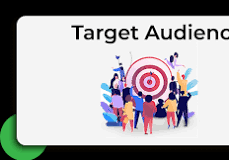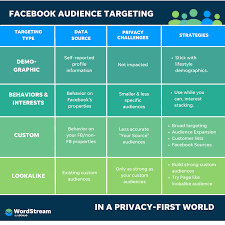Unlocking Success: How to Identify Your Target Audience Effectively
The Importance of Identifying Your Target Audience
Understanding your target audience is crucial for the success of any business or marketing campaign. By identifying and defining your target audience, you can tailor your products, services, and messaging to effectively reach and engage with the right people.
Why Identify Your Target Audience?
**Relevance:** Knowing your target audience allows you to create content and offers that are relevant and appealing to them. This increases the chances of capturing their interest and converting them into customers.
**Efficiency:** By focusing your efforts on a specific audience, you can allocate resources more efficiently and effectively. This helps in maximising the impact of your marketing strategies.
How to Identify Your Target Audience
**Market Research:** Conduct thorough market research to gather data on demographics, preferences, behaviours, and needs of potential customers.
**Customer Feedback:** Analyse feedback from existing customers to understand their motivations, pain points, and expectations.
**Create Buyer Personas:** Develop detailed buyer personas representing different segments of your target audience based on demographics, interests, challenges, and goals.
Benefits of Knowing Your Target Audience
**Personalisation:** Tailoring your marketing messages to specific audience segments allows for more personalised communication that resonates with individuals.
**Improved ROI:** Targeted marketing efforts result in higher conversion rates and better return on investment compared to generic campaigns that target a broad audience.
In Conclusion
Identifying your target audience is a fundamental step in developing successful marketing strategies. By understanding who your ideal customers are, you can create compelling content, products, and services that meet their needs and drive business growth.
8 Essential Tips for Identifying Your Target Audience
- Research demographics such as age, gender, location, and income level.
- Analyse the interests and hobbies of your potential audience.
- Consider the values and beliefs that resonate with your target audience.
- Identify where your audience spends their time online and offline.
- Gather feedback from existing customers to understand their needs and preferences.
- Monitor social media platforms to track conversations relevant to your industry or product.
- Create buyer personas based on common characteristics of your ideal customers.
- Test different marketing messages and channels to see what resonates best with your audience.
Research demographics such as age, gender, location, and income level.
When identifying your target audience, it is essential to conduct thorough research on demographics such as age, gender, location, and income level. Understanding these key factors provides valuable insights into the characteristics and preferences of your potential customers. By analysing demographic data, businesses can tailor their marketing strategies to effectively reach and engage with specific segments of the population, ensuring that their products or services resonate with the right audience. This targeted approach increases the likelihood of success in attracting and retaining customers who are most likely to convert and become loyal supporters of the brand.
Analyse the interests and hobbies of your potential audience.
To effectively identify your target audience, it is essential to analyse the interests and hobbies of your potential customers. Understanding what activities they enjoy and what topics they are passionate about can provide valuable insights into their preferences and behaviours. By delving into their interests and hobbies, you can tailor your marketing strategies to resonate with them on a personal level, creating a stronger connection that enhances engagement and drives conversions.
Consider the values and beliefs that resonate with your target audience.
When identifying your target audience, it is essential to consider the values and beliefs that resonate with them. Understanding what matters most to your audience allows you to align your messaging and offerings with their core beliefs, creating a stronger connection and sense of relevance. By incorporating values and beliefs that are important to your target audience into your marketing strategy, you can effectively engage with them on a deeper level, building trust and loyalty over time.
Identify where your audience spends their time online and offline.
To effectively identify your target audience, it is essential to determine where they spend their time both online and offline. Understanding the digital platforms, social media channels, websites, forums, and offline locations frequented by your audience can help you tailor your marketing strategies to reach them in the right places. By identifying these touchpoints, you can engage with your target audience more effectively and deliver relevant messages that resonate with them in their preferred online and offline environments.
Gather feedback from existing customers to understand their needs and preferences.
Gathering feedback from existing customers is a valuable tip in identifying your target audience. By actively listening to their opinions and preferences, businesses can gain insights into what resonates with their current customer base. Understanding the needs and preferences of existing customers allows companies to tailor their products, services, and marketing strategies to better meet the expectations of their target audience. This customer-centric approach not only fosters loyalty but also helps in attracting new customers who share similar characteristics and preferences.
Monitor social media platforms to track conversations relevant to your industry or product.
Monitoring social media platforms is a valuable tip when it comes to identifying your target audience. By tracking conversations related to your industry or product on platforms like Facebook, Twitter, and Instagram, you can gain valuable insights into the preferences, opinions, and behaviours of potential customers. This real-time data allows you to stay informed about trends, sentiment towards your brand, and emerging needs within your target audience. By actively listening and engaging with social media conversations, you can better understand your audience and tailor your marketing efforts to effectively reach and connect with them.
Create buyer personas based on common characteristics of your ideal customers.
Creating buyer personas based on common characteristics of your ideal customers is a valuable strategy in identifying your target audience. By developing detailed profiles that represent different segments of your customer base, you can gain deeper insights into their demographics, interests, behaviours, challenges, and goals. These personas help you visualise and understand the specific needs and preferences of your target audience, allowing you to tailor your marketing efforts to effectively engage with them. This approach enables you to create more personalised and targeted campaigns that resonate with individuals, ultimately leading to improved engagement, conversions, and business success.
Test different marketing messages and channels to see what resonates best with your audience.
To effectively identify your target audience, it is essential to test various marketing messages and channels to determine what resonates best with your audience. By experimenting with different approaches, you can gain valuable insights into the preferences and behaviours of your target demographic. This testing process allows you to refine your strategies and tailor your communication efforts to maximise engagement and conversion rates. Embracing this iterative approach enables you to fine-tune your marketing campaigns for optimal effectiveness in reaching and connecting with your desired audience.




